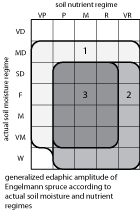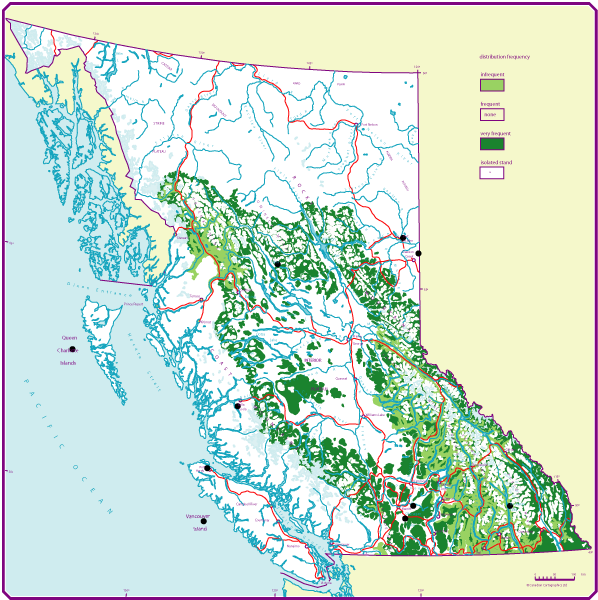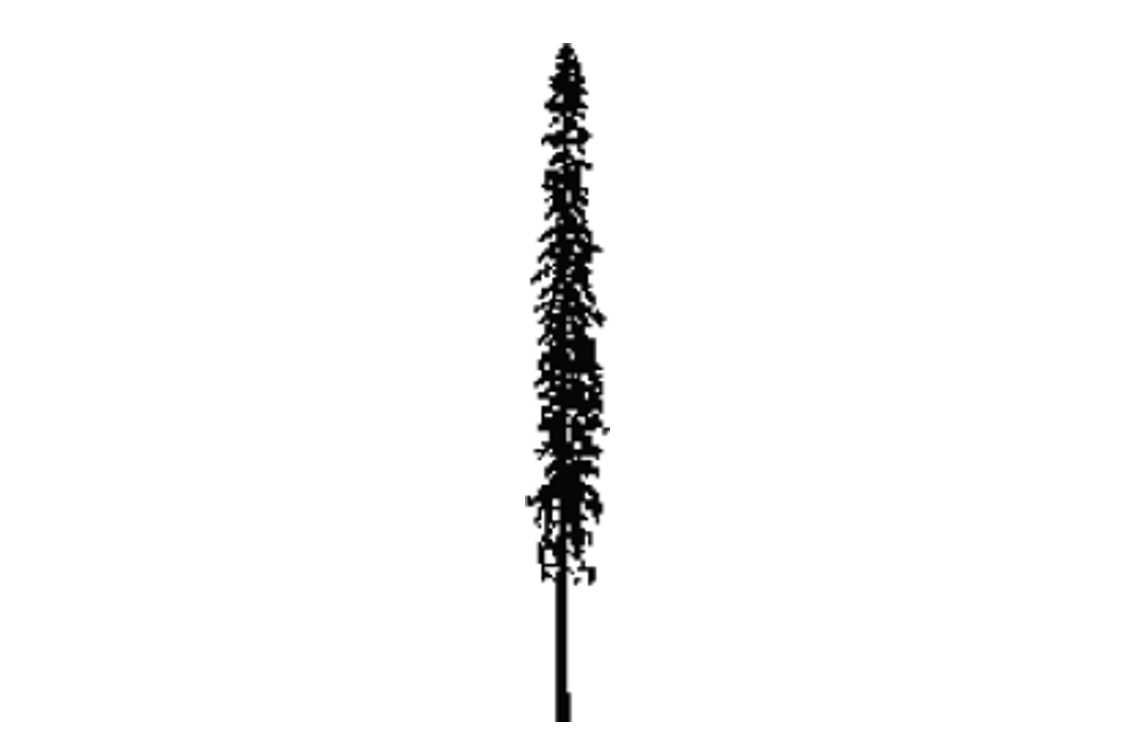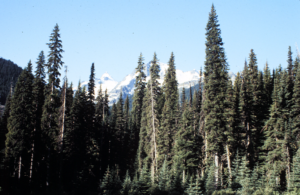Engelmann spruce
On this page
- Geographic range and ecological amplitudes
- Tolerances and damaging agents
- Silvical characteristics
- Genetics and notes
Geographic range and ecological amplitudes
Description
Engelmann spruce is one of the four spruce species indigenous to British Columbia. It is a medium- to large-sized (occasionally >50m tall), evergreen conifer, with a dense, symmetrical, narrow, spire-like crown; lower branches sloping downward; and a thin, gray-brown bark broken into large, loose, coarse, rounded scales. The wood of Engelmann spruce is used for lumber and pulp. Similar to the other spruces, the pulping properties of Engelmann spruce are excellent: long tracheids, light colour, and low content of resins.
Geographic range
Geographic element:
Western North American/Cordilleran and marginally Pacific
Distribution in Western North America:
(central) in the Pacific region; central and south in the Cordilleran region
Ecological amplitudes
Climatic amplitude:
(alpine tundra) - continental subalpine boreal - montane boreal - (cool temperate)
Orographic amplitude:
montane - subalpine - (alpine)
Occurrence in biogeoclimatic zones:
(lower AT), (submaritime MH), ESSF, (MS), (upper SBS), (upper IDF), (upper ICH), (upper submaritime CWH)
Edaphic amplitude

Range of soil moisture regimes:
(moderately dry) - slightly dry - fresh - moist - very moist - wet
Range of soil nutrient regimes:
(very poor) - poor - medium - rich - very rich
The vigorous growth of Engelmann spruce occurs in soils where calcium and magnesium are available in moderate, well-balanced quantities and on sites with Moder and Mull humus formations.
Tolerances and damaging agents
Root system characteristics
As with other native spruces, Engelmann has a shallow root system, with most roots within 50 cm from the ground surface. In deep, well-drained soils, the lateral roots may be longer than 200cm. Roots of Engelmann spruce are associated with both ecto- and endo-mycorrhizae.
| Tolerance to | Tolerance class | Comments |
|---|---|---|
| Low light | M | A moderately shade-tolerant species but less tolerant than its most common associate, subalpine fir. |
| Frost | H | |
| Heat | M | infrequent on montane sites |
| Water deficit | M | Infrequent on water-deficient sites. |
| Water surplus | H | Frequent on waterlogged sites. |
| Nutrient (mainly N) deficiency | M | Absent in acid, very poor soils. |
| Damaging agent | Resistance class | Comments |
|---|---|---|
| Snow | H | Protection-requiring on high snowpack sites. |
| Wind | L | shallow rooted, similar to white spruce |
| Risk class | ||
|---|---|---|
| Fire | H | Especially in dry subalpine climates. |
| Insect | M | Spruce beetle, western spruce budworm, white pine weevil, and the ragged sprucegall adelgid |
| Fungi | M | Root and butt rots in old-growth stands (Schweinitzii butt rot, tomentosus root rot, and red ring rot). |
Associated tree species and successional role
In British Columbia, Engelmann spruce grows in pure stands, but more frequently in mixed-species stands. It is present in early, mid-, and late stages of secondary succession; a minor component in old-growth stand in the submaritime MH, upper IDF, and submaritime CWH subzones, a variable component in old-growth stands in the ESSF zone.
| Associated tree species |
Occurance class | Major area of occurance |
|---|---|---|
| Subalpine fir | H | One of the most common associates. |
| Lodgepole pine | M | Upper montane boreal and throughout subalpine boreal climates in central and southern B.C. |
| Subalpine larch | L | upper southern ESSF |
| Limber pine | L | upper southern ESSF |
| Mountain hemlock | L | Upper ICH and submaritime MH. |
| Common douglas | L | Upper MS, ICH, and submaritime CWH. |
| Western hemlock | L | Upper ICH and submaritime CWH. |
| Whitebark pine | L | Upper southern ESSF. |
| Western larch | L | Upper southern MS and lower southern ESSF. |
| White spruce (& hybrids) | L | Upper MS and SBS. |
| Pacific silver fir | L | Wetter submaritime CWH and submaritime MH. |
Genetics and notes
Genetics
Population differences have been little studied, and there are no recognized races or geographical varieties. However, there is abundant evidence that natural introgressive hybridization occurs between Engelmann and white spruce and between Engelmann and Sitka spruces.
Natural hybridization between Engelmann and white spruce has been reported widely in the literature (Johnson 1939, Little 1953, Wright 1955, Garman 1957, Taylor 1959, Roche 1969). This hybridization, associated with easy introgression especially in the SBS zone, has resulted in this taxon being considered only as Picea glauca ssp. engelmannii (Parry ex Engelm.) (Taylor 1959). Because introgression is so common in British Columbia, it becomes hardly practical to use any binary name for the hybrid populations. Introgressive hybridization was discussed by Anderson (1949).
Engelmann spruce hybridizes less commonly with Sitka spruce (Wright 1955, Daubenmire 1968, Roche 1969); however, such a putative hybrid was observed in southwestern British Columbia (Klinka et al. 1982) in the submaritime CWH zone. No attempt was made to coin a binary nothomorph for this hybrid.
Notes
Engelmann spruce is a desirable component in pure or mixed-species stands in high-elevation interior forests. Because it is only occasionally affected by Indian paint fungus, which commonly destroys the heart wood of subalpine fir, Engelmann spruce should be maintained or even increased where timber production is the major management objective. More detailed silvics information is given by:
Alexander, R.R. and W.D. Shepperd. 1990. Picea engelmannii. Pp. 187-203 in R.M. Burns and B.H. Honkala (technical coordinators) Silvics of North America, Vol. 1. Agri. Handbook 654, USDA For. Serv., Washington, D.C.



